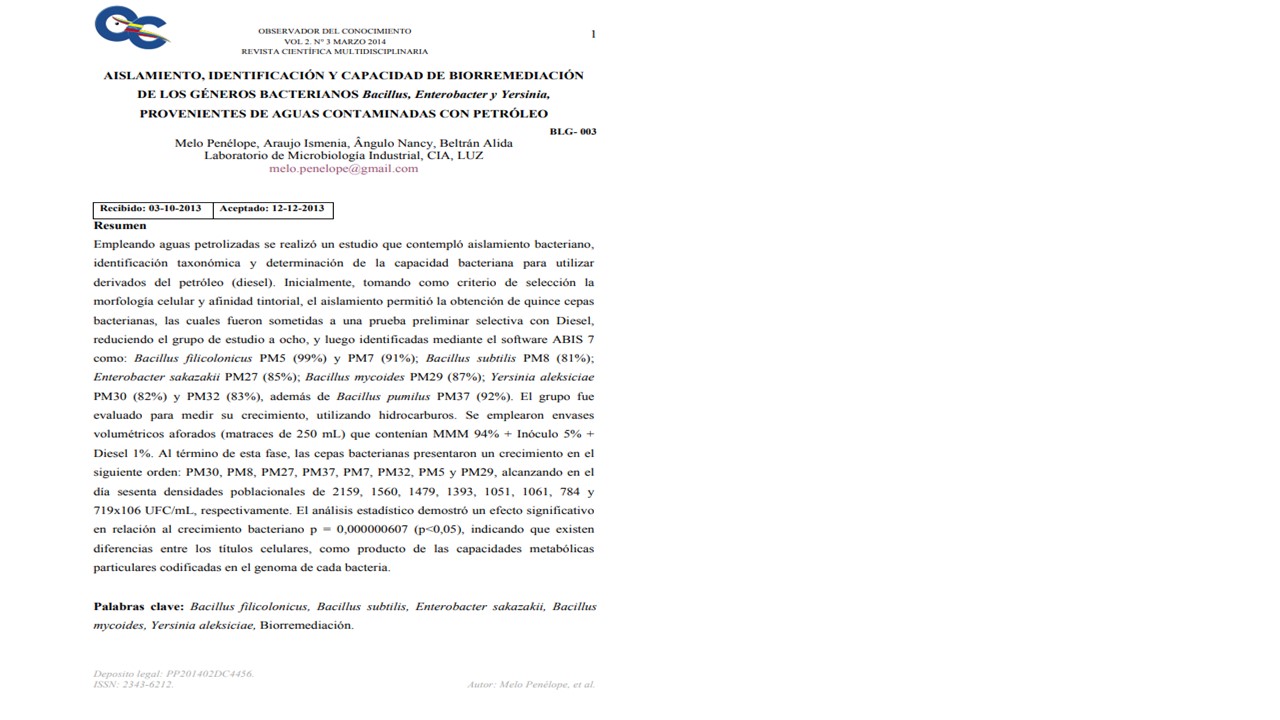Insulation, Identification and Capacity of Biorremediation of Genders Bacterials Bacillus, Enterobacter and Yersinia, From Polluted Water with Petroleum
Keywords:
Bacillus filicolonicus, Bacillus subtilis, Enterobacter sakazakii, Bacillus mycoides, Yersinia aleksiciae, BioremediationAbstract
Using petrolized waters, a study was carried out that included bacterial isolation, taxonomic identification and determination of the bacterial capacity to use petroleum derivatives (diesel). Initially, taking the cell morphology and tintorial affinity as a selection criterion, the isolation allowed obtaining fifteen bacterial strains, which were subjected to a selective preliminary test with Diesel, reducing the study group to eight, and then identified by the software ABIS 7 as: Bacillus filicolonicus PM5 (99%) and PM7 (91%); Bacillus subtilis PM8 (81%); Enterobacter sakazakii PM27 (85%); Bacillus mycoides PM29 (87%); Yersinia aleksiciae PM30 (82%) and PM32 (83%), in addition to Bacillus pumilus PM37 (92%).
Downloads
References
Advanced Bacterial Identification Software (ABIS) © (2007-2014), [en línea]. http: //www.tgw1916.net/ bacteria_logare.html
APHA, AWWA, WEF. (2005). Standard Methods for the Examination of Water and Wastewater. American Public Health Association. 21va Edición. Washington DC, USA.
Araujo, I.; Angulo N.; Cárdenas, C.; Méndez, M.; Morante, M.; Machado, M. (2004). Biorremediación de suelos con consorcio bacteriano, compostaje y fertilización. Boletín del Centro de Investigaciones Biológicas. 38 (3): 186- 202. Brown, L. (1987). Oil degrading microorganisms. Chemical Engineering Progress. 83 (10): 35-40.
Bhargava, R.; Pruthi, V. (2006). Oily sludge degradation by bacteria from Ankkleshwar, India. International Biodeterioration & Biodegradation. 57: 207-213.
ZoBell, C. E. (1946). Action of microorganisms on hydrocarbons. Bacteriology Reviews. 10 (1-2): 1-49.
Díaz, E. (2004). Bacterial degradation of aromatic pollutants: a paradigm of metabolic versatility. International Microbiology. 7: 173-180.
Gamazo, C.; Lopez-Goñi, I.; Díaz, R. (2005). Manual Práctico de Microbiología. Editorial Masson. Tercera Edición. Barcelona, España. 264 pp.
García, M. (2007). Crecimiento bacteriano en queroseno de cepas aisladas de una fosa petrolera. Trabajo de Grado para optar al título de Licenciada en Biología. Universidad del Zulia. Maracaibo-Venezuela. 91 pp.
Ghazali, F. M.; Rahman, R. N.; Salleh Z. A.; A. B., Barsi, M. (2004). Biodegradation of hydrocarbons in soil by microbial consortium. International Biodeterioration & Biodegradation. 54: 61-67.
Ibrahim, M. L.; Ijah, U. J. J., Manga, S. B., Rabah, A. B. (2008). Ocurrence of hydrocarbon utilizing bacteria in the rizhosphere of Eucalyptus camaldulensis, Lablab purpureus and Moringa oleifera. International Journal of Pure and Applied Sciences. 2 (3): 21- 26.
Ilyina, A.; Castillo, M. I.; Villareal, J. A.; Ramírez, G.; Candelas, J. (2003). Isolation of soil bacteria for bioremediation of hydrocarbon contamination. Moscow University Chemistry Bulletin. 44 (1): 88-91.
Jobson, A.; Cook, F.; Westlake, D. (1972). Microbial utilization of crude oil. Applied Microbiology. 23 (6): 1082- 1089Kerr, T. (1981). Applications in general microbiology: A laboratory manual. Second Edition. Hunter Publishing Company. Georgia, EEUU. 224 p.
Madigan, M.; Martinko, J.; Parker, J. (2000). Biología de los microorganismos. Prentince Hall. Madrid, España. 1089 p.
Mestre, M.C.; Vázquez, S.C.; Ruberto, L.; Mac Cormack, W.P. (2007). Identificación de los componentes cultivables del consorcio bacteriano degradador de hidrocarburos M10. Actas del VI Simposio Argentino sobre Investigaciones Antárticas. Instituto Antártico Argentino. Argentina. p 5.
Narváez-Flórez, S.; Gómez, M. L.; Martínez, M. M. (2008). Selección de bacterias con capacidad degradadora de hidrocarburos aisladas a partir de sedimentos del Caribe Colombiano. Boletín de Investigaciones Marítimas y Costeras. 37 (1): 61-75.
Prescott, L. M.; Harley, J. P.; Klein, D. A. (2004). Microbiología. 5ta Edición. MacGraw-Hill. Madrid, España. 1147 pp.
Rondón, M. (2000). Estudio de la compatibilidad de crecimiento de un cultivo mixto bacteriano para labiodegradación del gasoil. Trabajo de Grado para optar al título de Licenciada en Biología. Universidad de los Andes. Mérida, Venezuela. 55 p.
Seeley, H.; Vandemark, P. (1973). Manual de Laboratorio para Microbiología. Microbios en acción. Editorial Blume. Barcelona, España. 361 pp.
Toledo, F. L.; Calvo, C.; Rodelas, B.; González-López, J. (2006). Selection and identification of bacteria isolated from waste crude oil with polycyclic aromatic hydrocarbons. Systematic and Applied Microbiology. 29: 244–252.
Uaboi-Egbenni, P.O.; Amud, O. O.; Okolie, P. N.; Bisi-Johnson, M.; Akinyemi, O. (2010). Post-impact studies of an inland oilfield in South-Western Nigeria: A bacteriological perspective. Middle-East Journal of Scientific Research. 6 (3): 230-238.Verma, S.
ZoBell, C. E. (1946). Action of microorganisms on hydrocarbons. Bacteriology Reviews. 10 (1-2): 1-49.

Downloads
Published
How to Cite
Issue
Section
License

This work is licensed under a Creative Commons Attribution-NoDerivatives 4.0 International License.







